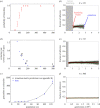Two-dimensional adaptive dynamics of evolutionary public goods games: finite-size effects on fixation probability and branching time
- PMID: 34084549
- PMCID: PMC8150049
- DOI: 10.1098/rsos.210182
Two-dimensional adaptive dynamics of evolutionary public goods games: finite-size effects on fixation probability and branching time
Abstract
Public goods games (PGGs) describe situations in which individuals contribute to a good at a private cost, but others can free-ride by receiving a share of the public benefit at no cost. The game occurs within local neighbourhoods, which are subsets of the whole population. Free-riding and maximal production are two extremes of a continuous spectrum of traits. We study the adaptive dynamics of production and neighbourhood size. We allow the public good production and the neighbourhood size to coevolve and observe evolutionary branching. We explain how an initially monomorphic population undergoes evolutionary branching in two dimensions to become a dimorphic population characterized by extremes of the spectrum of trait values. We find that population size plays a crucial role in determining the final state of the population. Small populations may not branch or may be subject to extinction of a subpopulation after branching. In small populations, stochastic effects become important and we calculate the probability of subpopulation extinction. Our work elucidates the evolutionary origins of heterogeneity in local PGGs among individuals of two traits (production and neighbourhood size), and the effects of stochasticity in two-dimensional trait space, where novel effects emerge.
Keywords: adaptive dynamics; ecology and evolution; evolutionary game theory.
© 2021 The Authors.
Figures




Similar articles
-
Adaptive dynamics of altruistic cooperation in a metapopulation: evolutionary emergence of cooperators and defectors or evolutionary suicide?Bull Math Biol. 2011 Nov;73(11):2605-26. doi: 10.1007/s11538-011-9638-4. Epub 2011 Feb 23. Bull Math Biol. 2011. PMID: 21347812
-
Evolutionary dynamics of continuous public goods games in structured populations.Chaos. 2025 Apr 1;35(4):043115. doi: 10.1063/5.0262821. Chaos. 2025. PMID: 40198250
-
Group-size diversity in public goods games.Evolution. 2012 Mar;66(3):623-636. doi: 10.1111/j.1558-5646.2011.01504.x. Epub 2011 Dec 21. Evolution. 2012. PMID: 22380428
-
Noncompliance With Safety Guidelines as a Free-Riding Strategy: An Evolutionary Game-Theoretic Approach to Cooperation During the COVID-19 Pandemic.Front Psychol. 2021 Mar 16;12:646892. doi: 10.3389/fpsyg.2021.646892. eCollection 2021. Front Psychol. 2021. PMID: 33796057 Free PMC article. Review.
-
Eco-evolutionary feedbacks between private and public goods: evidence from toxic algal blooms.Ecol Lett. 2016 Jan;19(1):81-97. doi: 10.1111/ele.12533. Epub 2015 Nov 27. Ecol Lett. 2016. PMID: 26612461 Review.
References
-
- Rood JP. 1975. Population dynamics and food habits of the banded mongoose. Afr. J. Ecol. 13, 89–111. (10.1111/j.1365-2028.1975.tb00125.x) - DOI
-
- Frank SA. 1998. Foundations of social evolution. Princeton, NJ: Princeton University Press.
Associated data
LinkOut - more resources
Full Text Sources

